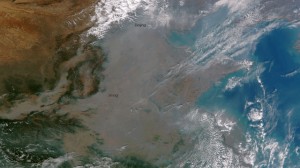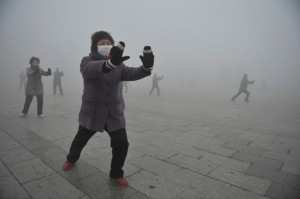Special to WorldTribune.com
By Donald Kirk, East-Asia-Intel.com
The Chinese are wielding a dangerous weapon that may have escaped the notice of military strategists.
While everyone worries about China’s territorial claims and growing influence from the Indian subcontinent to the Yellow Sea and North Korea, the more immediate threat posed by Middle Kingdom expansionism is the ultrafine dust that covers the Korean peninsula, blows over Japan and wafts as far as Hawaii and the continental U.S.

In fact, those targets sound awfully like those mentioned in reports of North Korea’s latest extra-long-range Taepodong missile.
If North Korean rhetoric boasts the fearsome weapon can carry a nuclear or biological or chemical warhead to the U.S. west coast, how about ultrafine dust laden with noxious ingredients?
The dangers associated with ultrafine dust suggest the Chinese may already be waging a form of biological-chemical warfare though no one’s accusing them of deliberately plotting to wipe out hundreds of millions. Leave it to the North Koreans to get around to that idea once they’re done with the latest charm offensive.
Consider the consequences. This stuff, if carried in fairly large quantities for years on end, can wind up having the same fatal effect upon the masses who breathe it as a fatal disease like the bird flu epidemic that periodically transfixes us. We live in a global village. Nobody is immune, and there are fewer and fewer places to hide.
True, you won’t see people collapsing on the streets as if they’d succumbed to a new form of germ warfare, but studies have shown the tiny particles picked up from the desserts of Mongolia and northern China and dispersed far and wide by wind currents high in the atmosphere already are shortening the lives of those who have to inhale it day after day.
No, the Chinese are by no means immune to their own poisonous air. More than anyone else, they’re likely to be the victims of pollution. Anyone visiting Beijing in recent years is familiar with the shock as soon as you get out of the airport of fumes from vehicle exhausts compounded by the smoke of nearby factories.
 No city I’ve ever visited has more air pollution than Beijing with the possible exception of New Delhi. The problem in India is not so much that of smoke-belching factories as it is of millions of vehicles, notably three-wheeled auto rickshaws that seem exempt from any regulations controlling emission of fumes.
No city I’ve ever visited has more air pollution than Beijing with the possible exception of New Delhi. The problem in India is not so much that of smoke-belching factories as it is of millions of vehicles, notably three-wheeled auto rickshaws that seem exempt from any regulations controlling emission of fumes.
I’m not sure who would win the contest for most poisonous air, though I think the edge goes to Beijing. Maybe it’s got more factories spewing grey smoke than Delhi. Shanghai and Mumbai, of course, are also contenders for the most dangerously polluted.
These problems, though, are local. The polluted air over large metropolitan areas may hang like a cloud for days on end but doesn’t always blow hundreds or thousands of miles.
Moreover, eventually rules and regulations may be able to curb the pollution of factories and vehicles though it’s difficult to imagine breathing pure fresh air in either Beijing or New Delhi or other large Chinese and Indian cities that I’ve visited. But what about enforcement? Forget it. Nobody’s seriously enforcing anything.
What is most baffling, though, is what to do about the ultrafine dust that’s swept up from barren deserts as well as vast swatches of land from which trees and shrubbery have long since disappeared in the struggle of desperate people to survive and the greed of commercial enterprises raping the Earth.
If authorities can impose rules and regulations on factories and motor vehicles, what can they do about the systematic defoliation of millions of square miles of land?
You don’t hear Chinese authorities worrying too much about the problem while the media in Korea warn of dust storms blowing particles over unsuspecting people, obscuring the sun in grey smog from which there is no escape.
Yes, ultrafine dust carries implications that are more alarming than you might guess from the daily “particle count” that no one really understands. Think of the possibilities for deliberately showering hostile countries with fatal chemical and biological compounds, taking germ warfare to an entirely new level.
Imagine enormous machines firing off clouds of bad stuff capable of traveling thousands of miles. No doubt the perpetrators would have to consider blowback, but surely the fiendish minds at work on these science-fictional weapons would have figured out a way to keep the clouds from turning around to haunt them in some weird reversal of wind currents.
All of which we should be considering as we venture forth into the polluted air. Don’t worry about alarmist reports of Chinese adventurism. Those are distant concerns. The chemically treated oxygen we breathe is here and now.
Columnist Donald Kirk, has been sniffing the polluted air of large Asian cities ever since writing about industrial air pollution in Japan for The New York Times Magazine more than 40 years ago. He’s at kirkdon@yahoo.com.

You must be logged in to post a comment Login